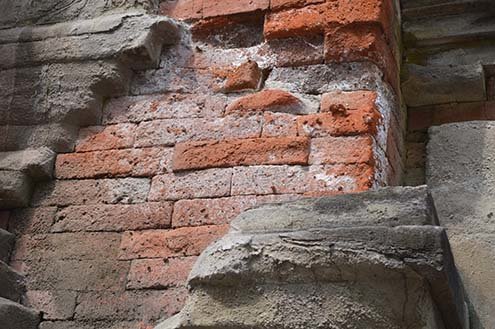Damage caused by salt crystallisation in masonry can be prevented by means of crystallisation modifiers. These modifiers can force salt to crystallise in a different way or to crystallise on the surface of the mortar instead. The Heritage & Technology chair hopes that this will solve this frequently occurring problem.
Salt crystallisation is a common problem in both historic and modern masonry. Salt can blow in from the sea, but can also be drawn up with rising damp or be found in the materials used to build a structure. When it dries, it crystallises, forming ugly ‘blooms’ and stains, and damages masonry and plaster. Salt crystallisation is difficult to fight because the source of the salt cannot always be removed, and often several types of salt are present in different proportions. “Modifiers added to the mortar can react directly with the salts that are present. They can then draw the salts to the surface or force them to crystallise in the material in a different way,” says chemist Sanne Granneman. “This prevents damage from occurring at a later point in time.” Granneman is devoting her doctoral research to this ‘self-healing’ technology.
Salt crystallisation is a common problem in both historic and modern masonry. Salt can blow in from the sea, but can also be drawn up with rising damp or be found in the materials used to build a structure. When it dries, it crystallises, forming ugly ‘blooms’ and stains, and damages masonry and plaster. Salt crystallisation is difficult to fight because the source of the salt cannot always be removed, and often several types of salt are present in different proportions. “Modifiers added to the mortar can react directly with the salts that are present. They can then draw the salts to the surface or force them to crystallise in the material in a different way,” says chemist Sanne Granneman. “This prevents damage from occurring at a later point in time.” Granneman is devoting her doctoral research to this ‘self-healing’ technology.
However, treatment with Borax in particular is still uncharted territory. In the coming period, further laboratory research should provide more clarity on the effectiveness of these two modifiers. As a final step in the research, the modifiers will be mixed into a mortar and their efficacy determined with the aid of an accelerated salt damage test. This is done by mixing up lime mortars with different quantities of modifiers. The mortar samples are then carbonated, impregnated with a salt solution and left in a climate cupboard, where they are alternately exposed to high and low humidity. This cycle is repeated several times and after each cycle the samples are weighed and photographed. This makes it possible to accurately observe to what extent the inclusion of the modifiers in the mortar reduces the amount of damage. This is hardly everyday research for the modest lab in the Faculty of Architecture and the Built Environment. “Fortunately, I am also able to use the Netherlands Organisation for Applied Scientific Research (TNO)’s Laboratory for Materials, Energy and Construction and the laboratory of the Institute of Physics at the University of Amsterdam – two of the project partners,” says Granneman.
In addition to TNO and the University of Amsterdam, Eindhoven University of Technology, two commercial companies (Strikolith B.V. and Delstuc Stucadoors) and the chair of Het Neerlandsch Stucgilde are also involved as project partners in the Heritage & Technology chair’s research. They are particularly interested in the results because successful use of modifiers could mean a breakthrough for a large number of restoration and renovation projects.
